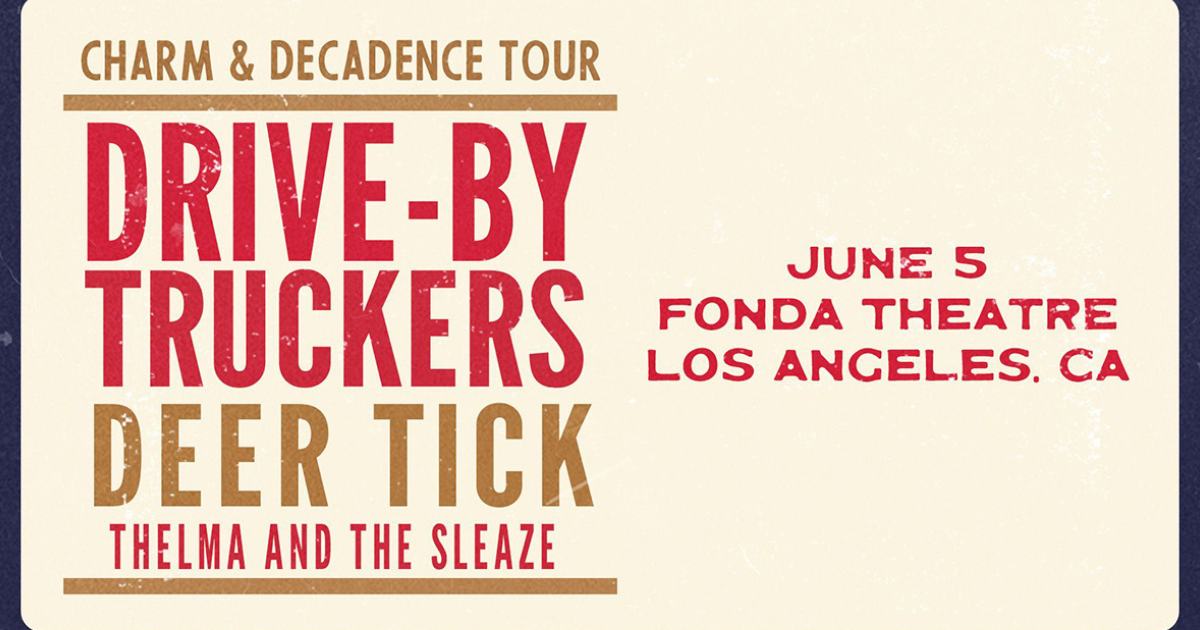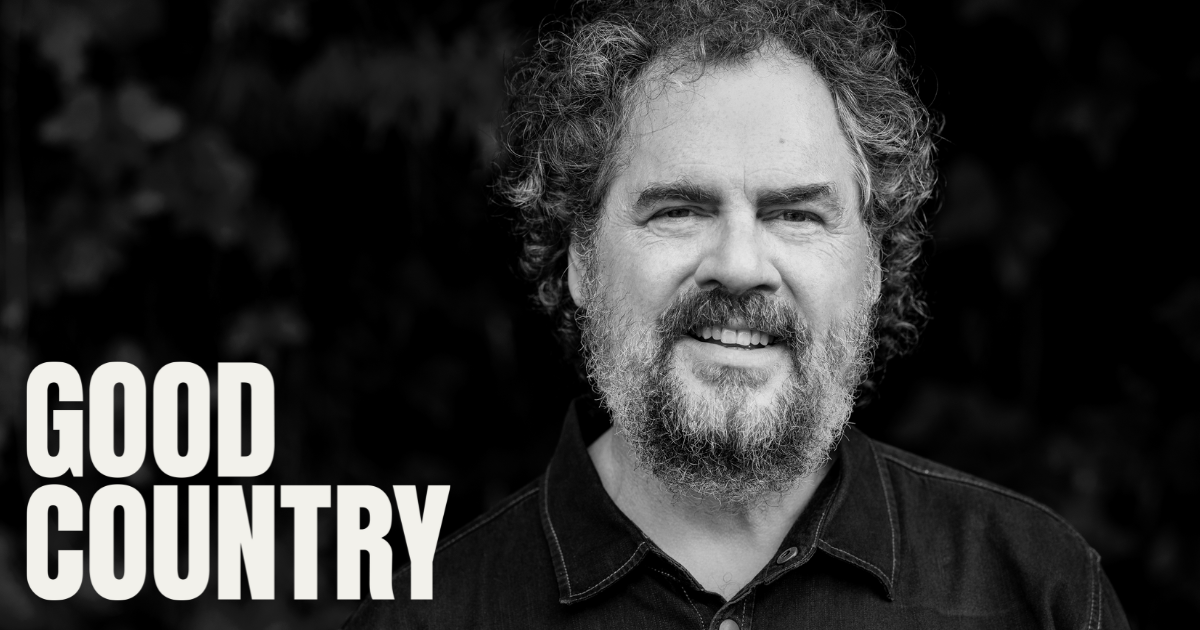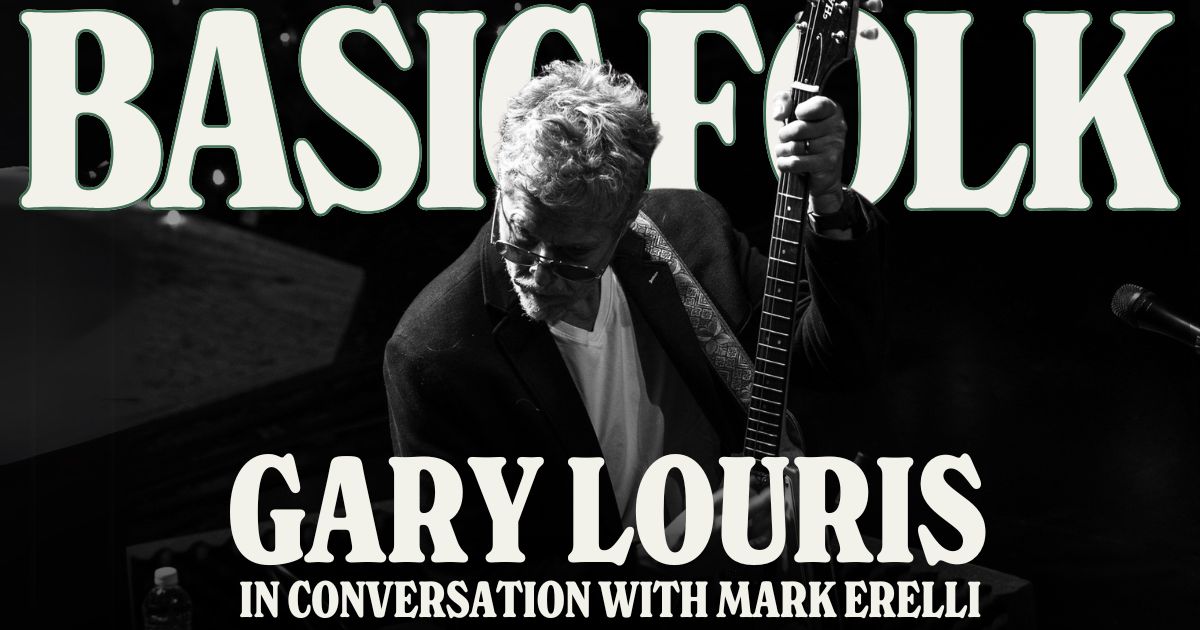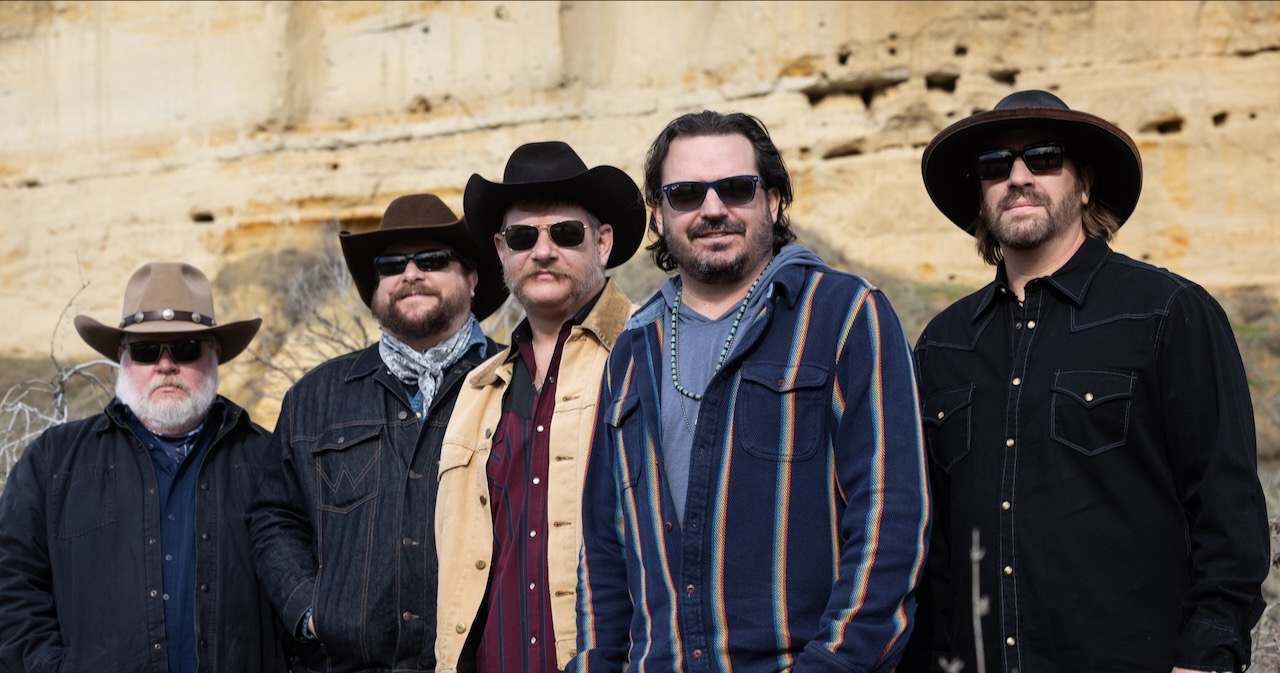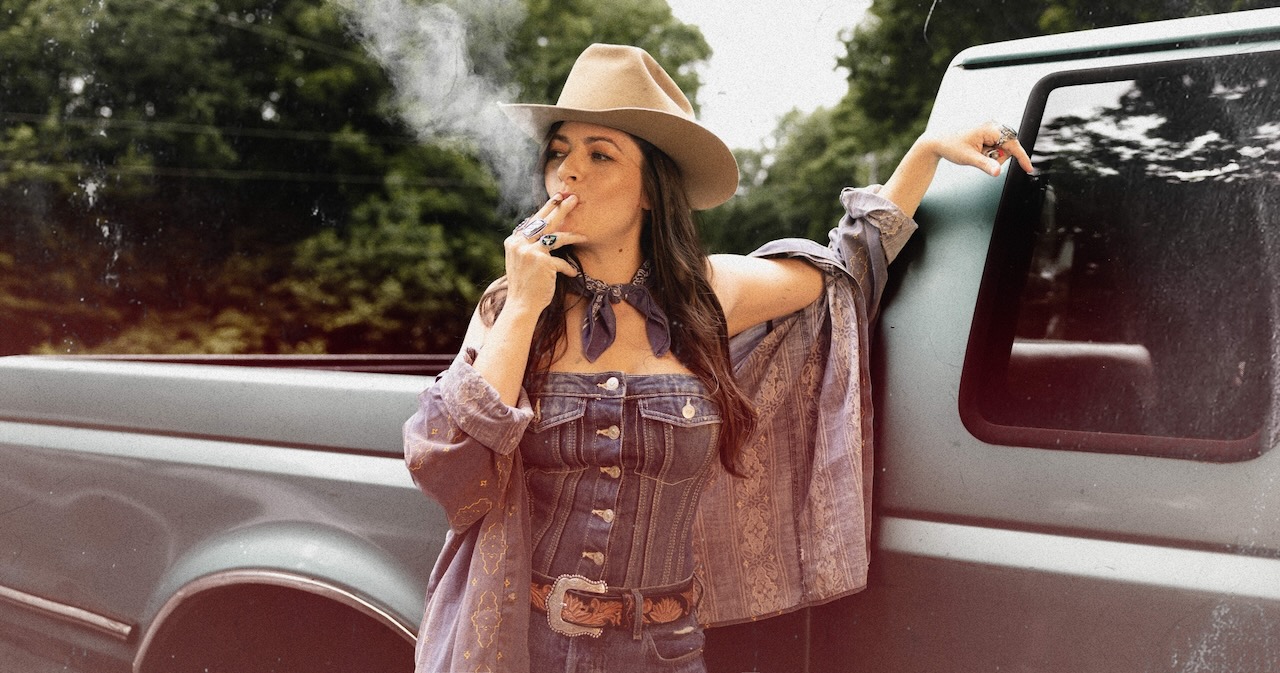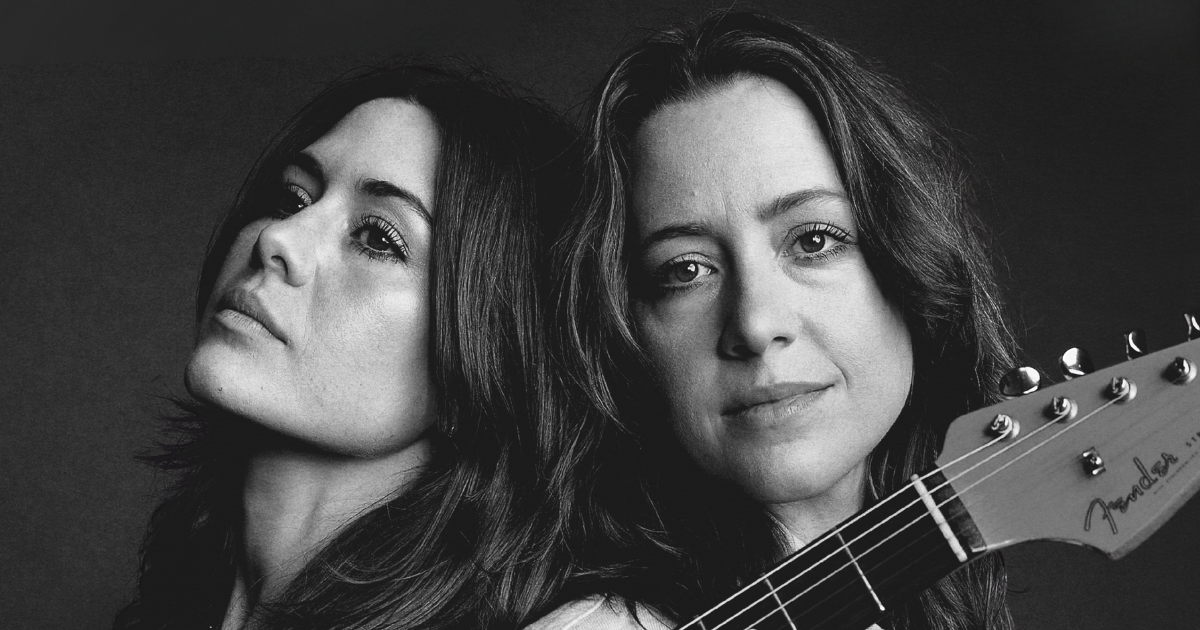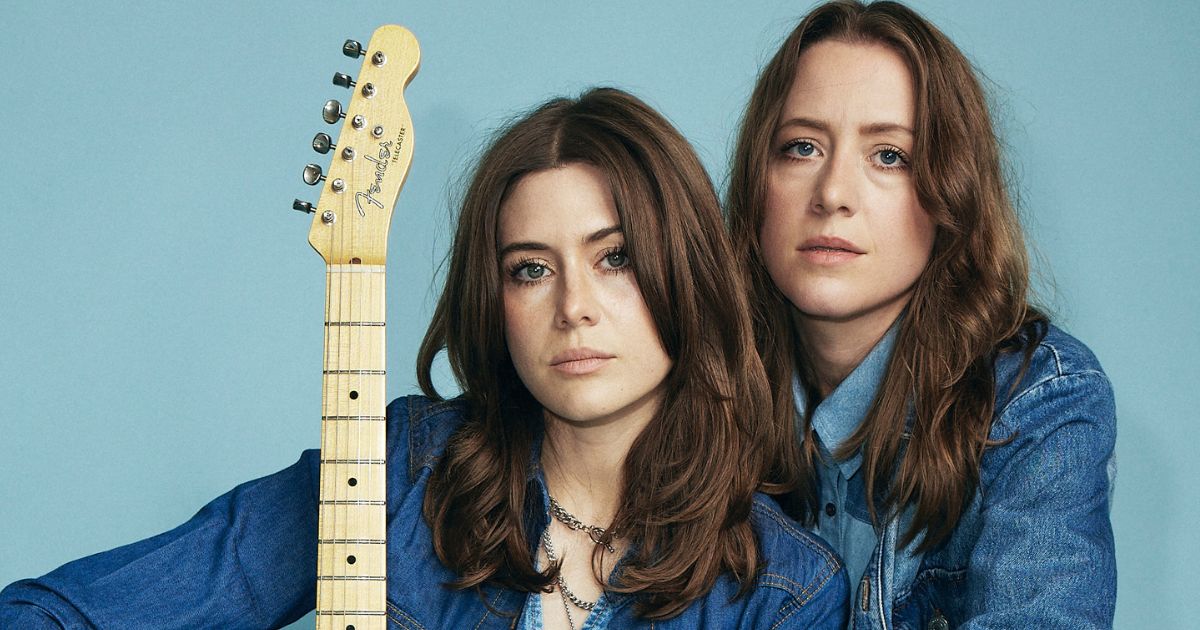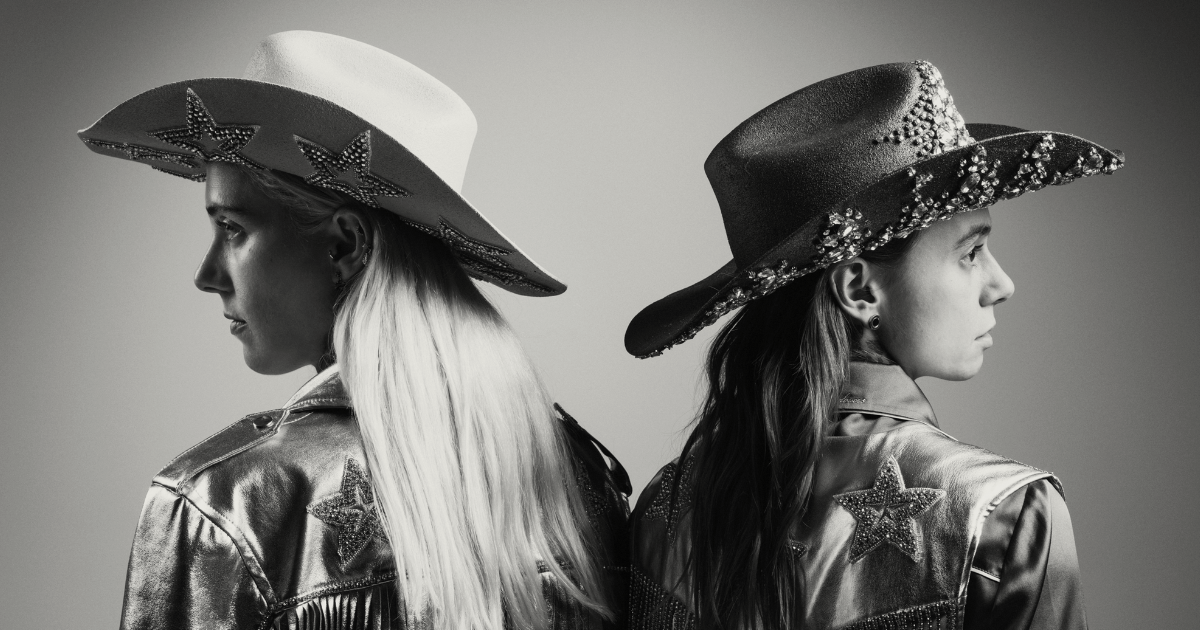Tag: alt-country
Opry 100: A Live Celebration
If you missed the Grand Ole Opry’s no-holds-barred 100th birthday party and live television broadcast extravaganza on NBC, we’ve got your recap right here on BGS.
Hosted by Blake Shelton at the historic Grand Ole Opry House in Nashville, Tennessee, Opry 100 included performances by artists like Vince Gill, Alison Krauss & Union Station, Lainey Wilson, Brad Paisley, Ashley McBryde, Reba McEntire, Dierks Bentley, Garth Brooks, Trisha Yearwood, and many more. The primetime broadcast and streaming concert is just one event among an incredible, chocked-full effort by the Opry to celebrate their centennial – officially November 28, 2025 – throughout the entire calendar year.
Over the two-hour broadcast, there were dozens of show-stopping moments, from the brash, bold, and sensational to tender, intimate, and heart-wrenching performances. Good country of all varieties was on display from a wide array of artists at all levels of notoriety.
The War and Treaty sang alongside Steven Curtis Chapman and Amy Grant; Vince Gill reunited with his old pals Jeff Taylor and Ricky Skaggs; Ashley McBryde brought the house down alongside superstar country newcomer Post Malone and elsewhere in the show, ’90s stalwart Terri Clark; Lainey Wilson shared the stage with country picker and renaissance man Marty Stuart; husband-and-wife Trisha Yearwood and Garth Brooks were on hand; and Brad Paisley and Alison Krauss reunited for their 2003 smash hit duet, “Whiskey Lullaby.”
The show wrapped with a stunning full cast tribute to Dolly Parton, who greeted the Opry House audience via video and gave her sincere regrets for not being able to appear at the event. (Parton’s husband of 58 years, Carl Dean, recently passed away.) Dozens of the evening’s star artists took to the stage to pay tribute to Parton by singing her most famous hit, “I Will Always Love You,” a perfect, soaring sing along to close the momentous show.
There are truly too many once in a lifetime collaborations, songs, moments, and performances from Opry 100 to list, but we’ve collected a few of our favorite moments so you can relive this once-in-a-lifetime – or once-in-a-century – show! Get your fix by traveling through a few of our own favorite moments from Opry 100: A Live Celebration below.
Blake Shelton Hosts
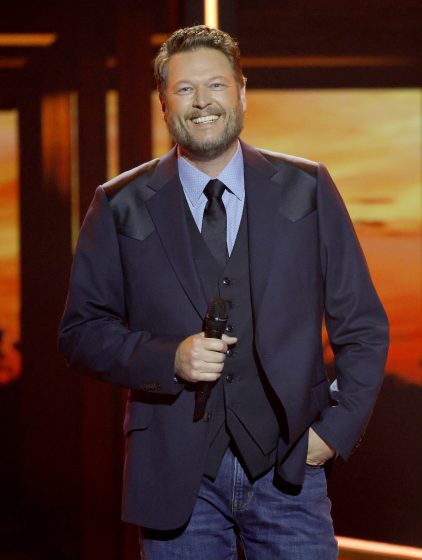
Country superstar, award winner, and television personality Blake Shelton was a more than qualified host for Opry 100: A Live Celebration. Of course, he also gave a rousing performance of Joe Diffie’s “Pickup Man” to the delight of everyone in the crowd who find somethin’ they like in a pickup man. It wouldn’t be a celebration of country or the Opry without a truck mention.
Nashville’s Own, the McCrary Sisters
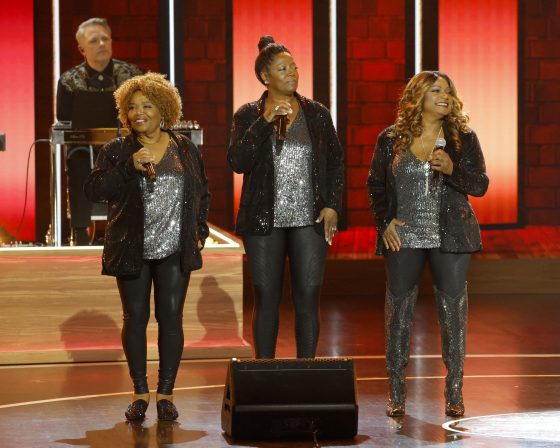
Nashville’s favorite, in-demand singing siblings, the McCrary Sisters were on hand for Opry 100, too. It’s certainly not their first time on the hallowed Opry stage, but in the centennial context their appearance reminds of the legacies of similar groups who blazed trails at the Opry before them – like the Pointer Sisters – and those who’ve followed in their footsteps, like the Shindellas and Chapel Hart.
Steven Curtis Chapman and the War and Treaty Share a Sacred Moment
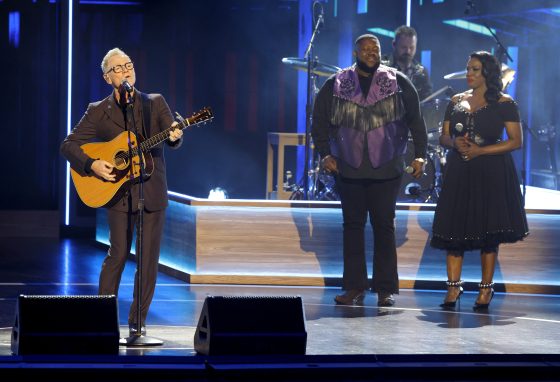
Grand Ole Opry member and contemporary Christian singer-songwriter Steven Curtis Chapman was joined by Americana/soul/country duo the War and Treaty for his performance on Opry 100.
Lainey Wilson and Hall of Famer Marty Stuart Duet
One of the biggest names in country at the moment, former GC and BGS Artist of the Month Lainey Wilson was joined by bluegrasser, fiery picker, and Country Music Hall of Famer Marty Stuart backing her up on mandolin. They perform “Things a Man Oughta Know” from her huge 2021 album, Sayin’ What I’m Thinkin’, which many regard as her breakout release.
Ashley McBryde with Post Malone and Terri Clark
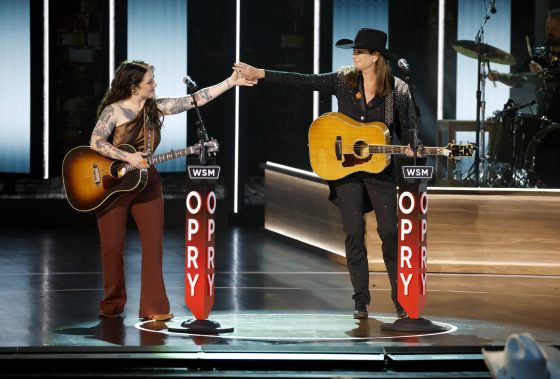
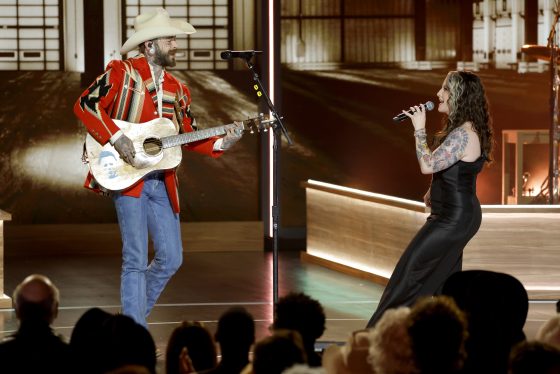
Ashley McBryde had multiple stellar moments during Opry 100, including these two prime duo performances. One with ’90s country star Terri Clark and another with a superstar newcomer to the genre, Post Malone. Her song selection with Postie was impeccable, too, taking the Opry 100 down to “Jackson” to mess around.
Trisha Yearwood with Garth Brooks and Reba McEntire
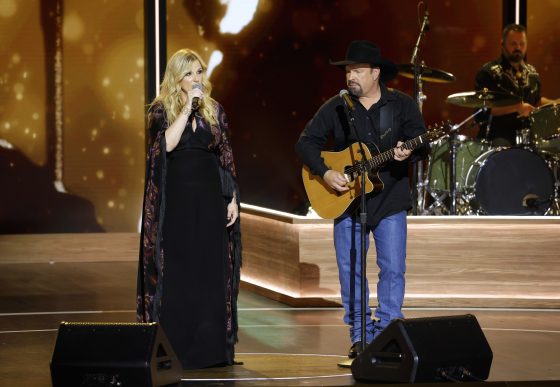
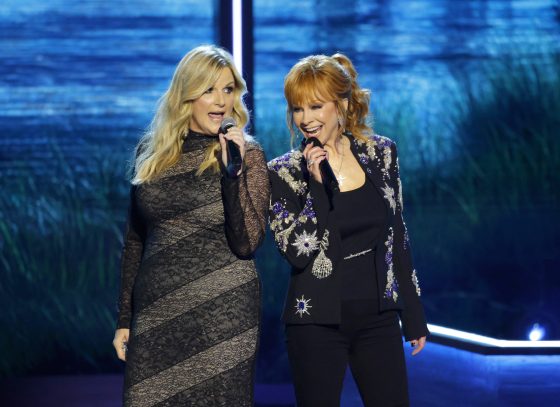
Country has boasted many amazing artist couples, but who better to take the Opry 100 stage than Trisha and Garth? Trisha also appeared with Reba McEntire to perform “The Night the Lights Went Out in Georgia,” a track that has been a huge generation-spanning hit for McEntire.
Brad Paisley and Alison Krauss Reunite
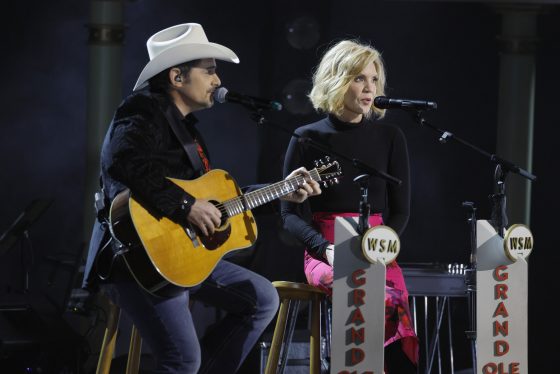
An iconoclastic example of a tear-jerker country story song, Paisley and Krauss’s recording of “Whiskey Lullaby” was released in the 2000s, but has had immense staying power. It shines from the Opry 100 stage in its simple and stripped-down styling. Is anyone a better duet partner and harmonizer than Alison Krauss? Perhaps not. Certainly a highlight among all of the many highlights of the broadcast
Alison Krauss & Union Station Perform, Too
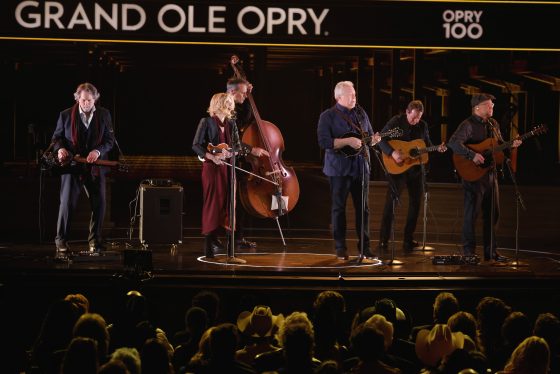
On the precipice of their first album release in over 14 years, Alison Krauss also brought her band Union Station – including newest member, Russell Moore – to the Opry 100 stage. Introduced by the Queen of Bluegrass, Rhonda Vincent, AKUS performed a hit from a prior era, “Let Me Touch You for Awhile” off 2001’s New Favorite. Their brand new project, Arcadia, releases March 28.
Country Music Hall of Fame Inductee, Vince Gill
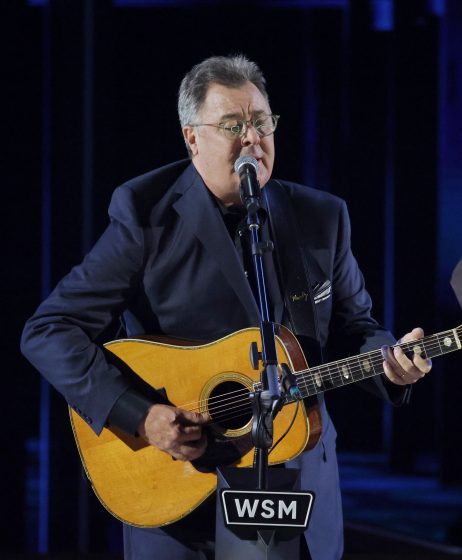
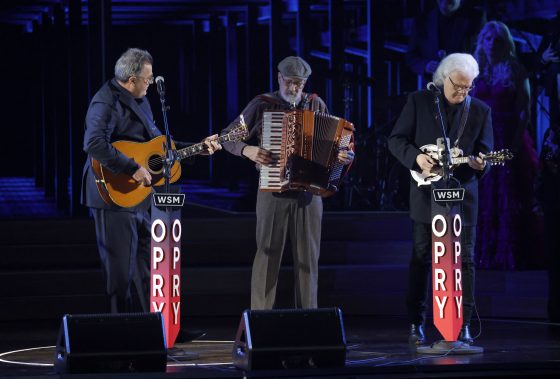
It wouldn’t have been a complete lineup for Opry 100 without Vince Gill! The Country Music Hall of Famer was joined by his old friends Jeff Taylor on accordion, Sonya Isaacs, and fellow inductee Ricky Skaggs, to sing perhaps his most famous song, “Go Rest High on that Mountain.” An impactful and inspiring number, the original has been a comfort to thousands of fans and listeners experiencing their own losses and grief. Of his deep-and-wide catalog of music, there’s not a better choice for an evening like Opry 100.
Ketch, Dierks, and Jamey

An Opry member trifecta, Dierks Bentley, Jamey Johnson, and old-time and bluegrass fiddler Ketch Secor (of Old Crow Medicine Show) paid tribute to the Charlie Daniels Band with a perfectly honky-tonkin’ medley of “Drinkin’ My Baby Goodbye” and, of course, “The Devil Went Down to Georgia.” From the sidewalks of Lower Broadway to the Grand Ole Opry stage, Charlie Daniel’s impact on country is indelible.
Luke Combs’ Mother Church Moment
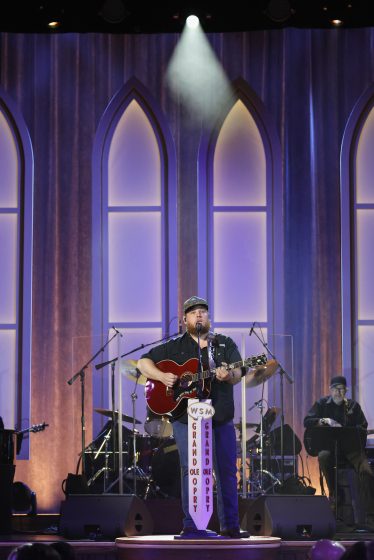
From the hallowed stage of the Ryman Auditorium, the most famous former home of the Grand Ole Opry, one of the most popular singers in all of country, Luke Combs, performed George Jones’ “The Grand Tour,” as well as “Hurricane,” for Opry 100. With more than 800 million streams (on Spotify alone), “Hurricane” is one of his biggest hits from his 2017 album, This One’s For You, which has been certified double platinum by RIAA.
This long list of our favorite Opry 100 moments is still, somehow, merely the tip of the country iceberg. Stay tuned as the Grand Ole Opry continues their 100th birthday celebration all year long.
All photos courtesy of the Grand Ole Opry; credit Getty/Jason Kempin.
Lead image: Brad Paisley and Alison Krauss perform “Whiskey Lullaby” live at Opry 100.
Exploding Trees & Airplane Screams
Most people know Patterson Hood as the frontman (really one of two frontmen) for the long-running rock band Drive-By Truckers. Had they come up in the 1970s instead of the ‘90s, the Truckers would have been mentioned in the same breath as bands like Lynyrd Skynyrd and The Allman Brothers Band. Led by Hood and fellow singer-guitarist Mike Cooley, they play kickass Southern rock — but the caveat is that this is intelligent kickass Southern rock. And much of the band’s sensibility is informed by Hood’s unique youth. He grew up in Alabama, but was raised by liberal parents (his dad is legendary Muscle Shoals bassist David Hood). As Patterson says, “Dualities have always been an obsession of mine and to some extent [of] the band itself.”
Over the years, Hood has also kept a solo career going on the side. But his new album, Exploding Trees & Airplane Screams, is unique for a couple of reasons. For one thing, it’s his first solo record in 12 years. For another, it’s a somewhat different beast, musically, from most of his albums – both with and without the Truckers. There’s considerably less guitar-based rock and roll, and other instruments, such as piano and even woodwinds, have been pushed more to the fore.
This is still very much a Patterson Hood disc. You can’t miss his distinct, gravelly vocals. His storytelling – often stories of what it was like to come of age in 1970s Alabama – retains a sharp eye for detail and the aforementioned dualities. There’s a lot of pathos in Hood’s writing, but there’s always some humor as well. Exploding Trees features appearances from the Truckers’ Brad Morgan and Jay Gonzalez (on drums and keyboards, respectively), not to mention Lydia Loveless (on the heartbreaking “A Werewolf and a Girl”), Steve Berlin, and producer Chris Funk, among others.
Good Country recently had the pleasure of catching up with Patterson Hood.
You’ve been very prolific with the Truckers, but Exploding Trees & Airplane Screams is your first solo album in more than a decade. Why a solo album now?
Patterson Hood: That’s a great question. The reason, I guess, is that I’ve been super busy with the band. The Truckers have been in a really good place for over a decade now. So I wasn’t particularly eager to do a side project just for the sake of doin’ one.
But [with] every album, there’s always a couple of songs that somehow get lost in the shuffle. Particularly after the record comes out – they turn out to be great tracks on the record, but they never get played live. So they are kind of forgotten songs that I care a lot about. I kind of started a file some years back for those songs. It’s not that the band can’t play them; the band played the shit out of ‘em. [It’s] more just the way our shows are, the flow of the show, the rooms we play. You know, the emphasis live often gets put on a certain level of rock, for lack of a better way of puttin’ it. There are songs that might be a little more introverted. So I’ve had a stack of those songs that were sitting there.
And I also, about 10 years ago, became friends with [producer] Chris Funk. We would play together from time to time, usually in the Northwest, because we both live in Portland. We had this cool chemistry. So for a long time, we’ve been talking about making a record together. And during the lockdown – when I was stuck and couldn’t go anywhere or do anything – I spent a lotta time up in my music room. I wasn’t really able to write a lot during lockdown, because my brain was just not functioning very well. I was very depressed. It didn’t make for good songs. But I could go back and go through song fragments and hone in on things. I could really edit like crazy! So I spent a lotta time working on those songs – instead of thinking in terms of what I would do in a rock band format, what I would do in not a rock band format. You know, like “I could hear woodwinds on this song!” Things like that.
We cut it pretty quick. But I spent a long time working on it before we recorded it, you know? Including Funk telling me a few months before we went in, “I hope you’re practicing that piano, because I want you to play it on the record.” I’m like, “No, that wasn’t the plan. The plan was to have someone who can actually play the damn thing!” I’m thankful, because if he hadn’t kicked my ass, I probably wouldn’t have played piano, to be honest. It forced me out of my comfort zone, which I think was as much the point as anything for him. I think he wanted to keep me in a state of perpetual terror! [Laughs]
I had been wondering if that was you playing most of the piano, whether it was Jay Gonzalez or someone else?
I played a lot of it. I mean, I’m not playing all of it; Jay’s definitely playin’ on it. And I think Funk and I both play piano on one song. Funk played a lotta synthesizers. Jay’s playing some old vintage weirdo keyboards that have names that I can’t even remember. Phil Cook played that organ part on “The Forks of Cypress” too. But as far as the songs that seem to be built around a simple piano part – that tends to be me. That’s what I play: simple piano parts! [Laughs] I’m not Randy Newman.
Can I ask you about a few of the specific tracks? I understand that “Exploding Trees” was based on an actual event.
Yeah. It was kind of like a meteorological phenomenon, I guess. It was in my hometown in February of 1994. It was right before my 30th birthday [and] right before I moved to Athens, Georgia. The weather had been warm and it rained a lot for a couple of weeks. It just rained and rained, you know? Borderline flood conditions. There’s a lot of pine trees, particularly in my home area. And they all got completely waterlogged by all the rain and with the warm temperatures.
Then there was this sudden freeze; the temperature dropped like 40 degrees in a couple of hours. And all the water in those trees froze. Particularly those pine trees – I guess they splinter easier anyway. The trees basically exploded all over town, kind of at the same time. Thousands of fucking trees! I mean, flattening cars, buildings, people. It was really awful. … And I had been out of town. I had ironically visited Athens a couple of nights before for the very first time – which directly led to me living there shortly after. I was driving back home as it happened; I basically drove right into the middle of it. I was trying to get to my grandmother’s house to check on her. I got to the house and there were, like, pieces of trees that had gone through the roof. And I couldn’t find her anywhere. [It turns out] she was fine. She was at a neighbor’s house.
I love the line “beauty queens in hospital gowns.”
Right. Well, one of the worst injuries of this storm was a girl I knew. I worked at a restaurant with her. She had just won Miss UNA, the beauty pageant, and was like two weeks away from going to compete for Miss Alabama. Lovely, lovely young woman. Very sweet – super Christian. And an oak tree fell on her car, with her in it. And it knocked her head down into her body cavity. It completely pulverized her neck and back – but she lived! She’s a quadriplegic [now, but] that accident led to [that line].
Oh God. That’s awful.
It feels like there’s a theme on a few songs of reckoning – coming to terms with past events, maybe.
Sure. Or trying to make sense of things. “Miss Coldiron’s Oldsmobile” – I was too young when that was happening to really wrap my head around what all of that meant. But as an adult, you can go, “Okay. She was being gaslighted, you know?” Every time she would ask for money, she’d get reminded of the mental hospital she had spent some time in. Things like that. It was pretty fucking insidious.
“The Van Pelt Parties” – you know, that was some of my first experiences with drinking and how adults partied. I was a little kid, sneaking booze from the punchbowl. I was the only kid at the party and we would go every year. And the older I got, the drunker I got. And the grownups were too drunk to notice! [Laughs]
Was Van Pelt a part of Alabama?
They were a family. He was a college professor, she was a schoolteacher. Their daughter was a painter who had been my babysitter. And my parents were right in the middle of their ages – kind of ended up becoming friends with all of them, with the daughter and the parents. So they were a big presence in my life growing up. You know, I loved ‘em. Their daughter, who’d been my babysitter, taught me a lot of cool stuff. She turned me on to some cool music. I actually have a painting she made after tripping on acid at a Doobie Brothers concert!
Maybe it was because we were young, but I think the ’70s had a much cooler vibe than the present.
Well, about anything’s better than [now]. I hate saying this so bad because I’m not prone to romanticizing the past; I’ve always rebelled against glory days. But right now sucks! The level of fucking misinformation and just the insanity right now is so insidious. It’s hard right now not to feel a certain amount of nostalgia for any time in the past.
You and Mike Cooley have been playing together for almost 40 years or more. And other members of the Truckers have come and gone. But the drummer, Brad Morgan, has been with you guys forever and we don’t hear a lot about him. Tell me a little about Brad and what he brings to the band.
The band wouldn’t exist without Brad. Brad was the glue that kept all this crazy shit together all these years. You know, he’s that guy that’s really even-keeled. And he brought that to the table at times when the band was far too tumultuous and emotional for our own good. We call him Easy B. There’s a golden rule in the band and that’s “Don’t piss off Easy B!” Because if you’re fucking up enough to where Easy B gets mad at you, you are fucking up! And you don’t want the phone call from Easy B! He doesn’t get mad often so if he’s mad, there’s a good reason for it and you better take heed. He’s also a colossal drummer. He so often takes such a subtle approach to things that people don’t realize what a bad-ass drummer he is.
I know you have some solo dates lined up. What can people look forward to when you’re touring with this album? I assume it’ll be a little different than a Truckers show?
Yeah! Very different. But at the same time, it’s the same universe. [Lydia Loveless] is in the band that’s touring this record. She’s gonna open the show and she’s gonna play bass and sing harmonies in my band.
I think anyone who’s into the Truckers – if they can tolerate my voice, they’ll probably like this too. [Laughs] If you’re there for the big frontal assault and guitars and sweat and spit that comes with a Truckers show, it’s very different. Although I’m not ruling out those things happening, too. But it’s a quieter show. It’s gonna be built around these songs, with some other stuff that stylistically or thematically works with this. And it’s cool.
Photo Credit: Jason Thrasher
Basic Folk: Gary Louris
(Editor’s Note: This special episode of Basic Folk featuring Gary Louris is guest-hosted by singer-songwriter and friend of the podcast Mark Erelli.)
You probably know Gary Louris as the leader of The Jayhawks – or as they refer to themselves, “a band from Minnesota.” The Jayhawks are pioneers of roots rock, alt-country, and Americana. Whatever you wanna call it, they’ve been making records where rock, pop, country, and other forms of American roots music overlap since the mid-1980s.
But Louris’s hidden superpower is that he’s kind of like a musical Swiss Army knife – he’s basically got a creative skill for any application. Want him and his band to serve as accompanists for some of the most distinctive singer-songwriters, like Wesley Stage and Joe Henry? He can do that. Looking for achingly perfect, near-fraternal harmonies on hit songs like Counting Crows’ “Mr. Jones”? He can (and did) do that. If you’re Tedeschi Trucks Band or The Chicks and looking for someone to write you some catchy, melodic, roots-pop songs? Gary’s your guy. If that’s not enough, he has also produced records for artists like Dar Williams, The Sadies, and The Jayhawks, too. Whatever your musical need may be, chances are that Gary Louris can do it.
LISTEN: APPLE • SPOTIFY • AMAZON • MP3
In between all these varied musical roles, Louris has also found time to release several solo albums, the newest of which – Dark Country – was released earlier this month. He recorded it mostly solo in his home studio and the word on the street is that this collection of songs, inspired by his wife, is his most intimate and romantic album yet. I’ve been a big fan of Gary Louris for basically my entire adult life and enjoyed our wide-ranging Basic Folk conversation, touching on the way technical limitations can shape an artist’s style, what he’s learned from a career’s worth of collaborations, his process working on his new solo album, the relationship between versatility and longevity, and what the influence of romance on his songwriting looks like now, in the fifth decade of his music career.
Listen to Mark Erelli guest on Basic Folk here.
Photo Credit: Steve Cohen
WATCH: Reckless Kelly Go Behind the Scenes of “What’s Left of My Heart” Video
Austin, Texas-based alt-country rockers Reckless Kelly released their music video for “What’s Left of My Heart” – from their 2024 album, The Last Frontier – a handful of months ago. Now, they’ve returned with a special “Pop-Up Music Video” that takes viewers behind the scenes of the making of the video. (Watch below.)
Bits of commentary, context, insight, facts, and fun “pop up” as noteworthy action occurs on screen, bringing outlaw country fans into the processes that led to the zany and fun visual rendition of the track. Set in the now-legendary South Austin honky-tonk Giddy Ups, just days before it permanently closed its doors, the video includes plenty of Easter eggs and details that would have easily gone overlooked if not for the illuminating pop-ups. Viewers follow frontman Willy Braun through a series of hijinx brought on – or enhanced by? – the band’s informal mantra, “sorry for partying.”
“We shot the entire video in about five hours after a show,” Willy’s brother and bandmate Cody Braun explains via press release, “So a ton of pre-prep and organizing had to happen. It was amazing to have friends, family, and musician buddies join us and bring this vision to life. Giddy Ups was one of our favorite spots, and as Austin changes, we wanted to give it a proper send-off.”
“What’s Left of My Heart” is certainly that send-off, but with so many collaborators, actors, cameos, industry folks, and special guests, the behind-the-scenes touches of the pop-up video help illustrate how important community and family are to the band over the decades. There’s so much to see and hear in “What’s Left of My Heart,” we don’t want to give any of it away! So don’t miss a single beat and watch Reckless Kelly’s new pop-up music video.
Want more Good Country? Sign up on Substack to receive our monthly email newsletter full of Good Country direct to your inbox.
Photo Credit: Robert Millage
Video Credit: Co-directed by Tony Gates and Cody Braun.
BGS 5+5: Olivia Wolf
(Welcome to another 5+5! Hit play, scroll, and get to know artists, creators, and roots musicians of all sorts with five questions and five songs.)
Artist: Olivia Wolf
Hometown: Leipers Fork, Tennessee
Latest Album: Silver Rounds
Which artist has influenced you the most – and how?
Gillian Welch. She has shown me that lyrics can be both beautiful and dark, honest and true. Her instrumentation is brilliantly simple and to see her play live is to transcend to a different plane.
What’s your favorite memory from being on stage?
We played “The Wild” in Seattle, and I asked if anybody had gone fishing that day. A fella had been out that morning and caught three coho salmon. When the song started he closed his eyes and I knew he was back on the ocean in the breeze and the water. I love to see other people getting to escape through my music.
What other art forms – literature, film, dance, painting, etc. – inform your music?
Photography, antiquing and home décor design, cooking, and hosting friends.
What is a genre, album, artist, musician, or song that you adore that would surprise people?
I love Daft Punk. Especially their song “Something About Us.” They influenced a lot of the cosmic aspect of my album and I greatly admire their lyrics and musicality.
If you didn’t work in music, what would you do instead?
There is nothing I could do instead, I am married to the music.
Photo Credit: Alysse Gafkjen
Larkin Poe Continue to Bloom
Megan and Rebecca Lovell are Larkin Poe, a band that nestles into a myriad of genres – and the sisters are good with that. Their newest full-length album effort, Bloom, out January 24, comes fresh off the heels of a GRAMMY win for Best Contemporary Blues Album with last year’s Blood Harmony. They also landed Duo of the Year at 2024’s Americana Honors & Awards, proving that by digging into their own stories, collaborating even when it isn’t easy, and filtering it all through what the music will feel like on stage, they carve a sound that knocks down doors into multiple genre territories.
Independent spirit permeates everything the sisters do, from the way they write and produce the music to how they map out the aesthetics of how they present the work. Bloom is no exception, finding the women delving deeply into personal and social themes in a way they say they have not before, the result of getting real with each other and learning how to collaborate through the writing process.
In “You Are the River,” we find them contemplating a common theme throughout the album, that sometimes the best and the worst are married inextricably and tie us to each other.
The sand in the oyster
The pressure on the coal
The sum of the parts is greater than the whole
A chain of reactions
A butterfly’s wing
My hand holding yours to form another link
For our Artist of the Month interview, BGS spoke with Megan and Rebecca via Zoom from their respective homes in Nashville. The Lovells discuss the challenges and joy of writing together, the evolution of their relationship with their fans, and the pressures of public life in the age of social media.
You all have been lauded in multiple genres, from blues to Americana. You are also identified as a rock and roll band and here we are talking on a bluegrass outlet. What do you think about genres in general, and do you consider them at all during creation of the music?
Rebecca Lovell: One of the greatest pieces of advice that we’ve ever received was from Mr. Elvis Costello. Many, many years ago, he advised us to defy the temptation to put ourselves into a genre box. He has lived up to that creed himself, having made bluegrass, gospel, country, punk, rock records, operatic records, and musical records.
For us, having been able to sample all the different facets of who we are as people and music lovers allows us to connect with the people who are consuming our music. I think increasingly, all of us consume music from a wide range of genres. I do think that that’s one gift of streaming platforms. The very barest of silver lining is that it opens up your mind to the fact that there is great music to be found in every genre, and I think genre-blending is the way of the future.
So we call what we do roots rock and roll, which is intentionally very vague because we get great joy out of letting the many flavors of our musical heritage be represented. That allowed us this past summer to play at a bluegrass festival and then play at a world music festival, play at a pop festival, a rock festival, a country festival, and it keeps it fresh. It keeps it exciting.
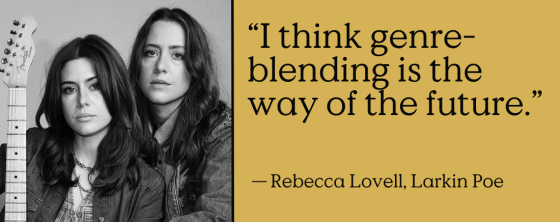
You’ve won awards in multiple genres, especially in the past few years. I was curious: are awards ever a motivator for you? Do you ever think about them when you’re creating?
Megan Lovell: Winning awards is a very new thing for us. We’ve always made music with a different focus, because we’ve always felt that the real reward is people being willing to stand in line or travel and buy a ticket and wait at the venue for us to come and play. So that’s always been our focus. Not to say that winning an award isn’t a cool experience, and definitely something we’re super appreciative of, but I don’t think it’s something we consider when we’re writing or recording.
We’re definitely thinking about our live show. We’re really writing intentionally, thinking about how it will feel when we’re touring. Because that’s what we do most of the year is tour.
Tell me about your writing process, both when it’s just you two as sisters, bandmates, and business owners and then also when you bring in other folks to collaborate.
RL: I think Bloom represents a really cool point in our evolution as creative collaborators. Since the ground up, Megan and I have been projecting together since we were little kids. It’s felt like [there was] a lot of foreshadowing in our childhood that we would work together, because we’ve always been so collaborative. But songwriting was one of the last holdouts of our working relationship that there was friction in. I’m sure it has to do with the fact that there is a piece of this sibling rivalry thing. But getting older, being more comfortable with and accepting your flaws, and being able to then have the self-confidence in a writing session to throw out ideas – that inherently, because they are ideas, they’re not fully fledged. They can be misunderstood or sound stupid.
I think we’d had some writing experiences in the past where we had not had the best of times. It just felt like a lot of false starts. We typically had written separately, but something clicked in the last 6 to 8 months leading up to the writing process for Bloom. We made the commitment to and had many conversations about writing the record together, and I really think you can hear the progress that we made as a team in manifesting that true creative collaboration. I think the songs are so much better.
There was a real commitment to being very intentional with everything that we said on this record. Being a songwriter and a performer, there is always this temptation to self-aggrandize, or build a character for yourself, or be the movie theatrical version of who you are and what your life feels like. I specifically have written from that space in the past and listening back, we wanted to do something different this time. That was our consensus. We went through every song, every lyric on this record with a fine-tooth comb, to ensure that real vulnerable authenticity was represented in the lyrics. That took a lot of courage and I am really proud of us for making that commitment, and being able to actually pull it off with this album.
ML: You know, what’s funny is, when we were thinking about bringing in a third collaborator, did we go outside? No, we actually end up working with Rebecca’s husband [Tyler Bryant] a lot. So we have that sibling dynamic and the husband-and-wife dynamic. We really like to complicate things.
RL: There is a certain shorthand that exists when someone knows you really well, when you know someone really well, and especially between Megan and myself – and also Tyler. We all have very closely mirrored musical upbringings and we have a lot of kindred spirit energy in the records that we’re all referencing for the production and the songwriting.
It does create this space, when handled correctly, for being really truthful, being really genuine, and allowing yourself to actually go to those spaces. I was the big crybaby on this record. I was weeping in these co-writes, like inconsolable. But that allows you to really channel some specific, detailed stuff from your own experience. The more specific you’re able to get with yourself, the more likely it is you’re going to be able to connect with other people. And that is our biggest motivator.
That’s so wonderful. Speaking of, what is your relationship with your fans like? And do you see it evolving as you change your process and become more open that way?
ML: We have a lot of musically deep music lovers and they’re really cool, knowledgeable people. I think because we’ve kind of always been a little bit left of center, we’ve attracted a cool audience; people who appreciate the do-it-yourself attitude and people who just really want to support a grassroots effort.
We’ve had people who have been following now for decades, which is strange to be able to say, but they’ve really stuck with it. Of course, those relationships do shift over time. And certainly through the pandemic. That was a huge shift in the way that we related to people, because we were using the internet to connect. We had these pretty spiritual conversations with people that I’m not sure would have happened if we hadn’t been online and talking all of the time. We came out of the pandemic with a lot more intimate fans.
Can you talk about the recording process? Where did you cut this record? How did you decide to bring in your husband as co-producer?
RL: I do think the pandemic played a big role in the shift of Megan and myself bringing Tyler Bryant in as a co-producer because, for the last 10 years, we’ve been self-producing our records. At Megan’s behest as the big sister, she was like, “It’s time. We need to self-produce our records.” That was very scary at first, but we got our feet wet and got our bearings.
Ultimately, we’re so grateful that we made that shift, because it allowed us to hold the reins in the studio and steer the music in the direction that we wanted to go. Through the pandemic, we built a state of the art recording studio in the basement of our home, and we wanted to make records. We didn’t want to hold up our creative process. We were still distancing in our bubble. But it was the group of us, and by necessity we started recording in that home studio; we’re kind of blown away at the sounds we could get. There was an effortless nature of being in a really safe home environment.
When Megan and I tour with our band, we’re a four-piece, so we set up as a four-piece in the studio and went for it. Hopefully, that will allow our records to age gracefully because they are very true and very stripped down to who we are as a band.
ML: But honestly, when we were going to studios, we were experiencing a lot of Keurig machines and we like really nice espresso machines. So we made the decision to stay home.
Let’s talk about the song “Pearls.” It seems to be built around the idea of maintaining a sense of self while you’re navigating the world that’s constantly reflecting you in such a public way. I wanted to know, as family and as bandmates and business partners, how do you navigate the ever-changing and tumultuous world of being in the public eye, especially in the age of social media?
RL: I think it’s one of the hardest things. It is so challenging to exist in a space where you need to have just enough ego to get on stage and perform. But you can’t identify too much with that ego, because then you’re creating a very limited, narrow lane for yourself. But don’t have too big of an ego, because then you’re going to be a bitch and nobody’s gonna like you. So it’s this weird straddling of all these different elements of our identities. And then we’re having to do that together.
With so much shared experience between us, Megan knows the true me. I think that you and I have cultivated a great deal of grace, allowing that true nature to evolve. Who we were when we were 5, is simultaneously the same as who we are now, and also very, very different. Allowing that leeway for ourselves is only something that we’ve started really engaging with in the last 5 years. Right, Megan?
ML: Yeah, we’ve had a lot of conversations over the last couple of years. We are coming to more of an understanding of where the tension was coming from, from who we are as people, and then who we expect ourselves to be on stage. Then also that sort of external pressure that everybody has that we also felt from a very young age from the people around us. There are people in the industry who expect us to be something and then fans who come and meet us. There are a lot of opinions flying around, but you really don’t have to take anything on board that you don’t want to.
Whether it’s that one negative comment on a post that you for some reason have to obsess about, even though there are 99% positive comments. You just can’t get that negative comment out of your head and I don’t even know if I trust that person’s opinion. It’s a good reminder to just steer your own ship.
You mentioned different kinds of festivals, different genres of festivals. When you think about your tour, what kind of stage do you feel the most at home on? Is it a festival? Is it a club or theater? Is it a genre of festival?
ML: 2025 is going to be a big year for touring. Last year we played a lot of festivals. This year we are playing a lot of headline shows and we’re going to start in the U.S. and go through the spring. Then we’re gonna do a big fall European tour. And it’s shaping up to be really, really amazing. We have a really substantial following over in Europe. We have done a lot of work over there. There’s some bucket list venues that we’re gonna play.
I love a headline show. You know, where the place is packed, and there’s that energy in the audience, and everybody knows the lyrics. There’s nothing that beats that vibe and you can find that anywhere. You can find it in a tiny rock club to an arena or a festival. The important thing is that people are engaged from the stage to the audience, and vice versa.
Same for you, Rebecca?
RL: Yeah, I agree. I love a headline date, I think, especially because Megan and I are album people. We like a body of work. I like to sit down and listen to an artist’s album from the beginning to the end to try and get a sense of where they were at when they were writing the record. Megan and I, when we make our records, we obsess about the content, about the story arc, about the sequencing of the record, about the packaging, about the font.
And I think we get that same kind of energy in a headline show because we’re thinking about the colors of lights and which of the songs we are going to include and how much of the old material. We really want to have that space with the music and the emotional content of the music, and you feel that energy, and you feel that resonance. If everything goes right and everyone has their hearts open, you gain access to this portal where I think a lot of transformative change can happen between humans. And that’s what we seek.
Photo courtesy of the artist.
Flatland Cavalry’s 10th Anniversary Compilation, ‘Flatland Forever,’ Traces Their Rise
Ten years after a band of college friends played their first show in Lubbock, Texas, Flatland Cavalry have finally stopped moving to take a look around. Released in early November, their latest album, Flatland Forever, is a 25-song chronological opus, sampling key tracks from their six acclaimed albums. But, as with most things the band does, it isn’t your typical “greatest hits” package.
Also finding space for a few unreleased gems, Flatland Forever traces the contours of a remarkable roots music rise. This Cavalry has ridden to the rescue of countless country fans, pushing an indie ethos deep into the mainstream while retaining a self-contained spirit, and the Forever project offers new listeners an easy way to get up to speed.
Their 10 years have seen Flatland gather 500 million streams and a Gold certification for the tender “A Life Where We Work Out,” while establishing their live-band cred alongside the genre’s best and brightest. 2024 alone saw them score their first ACM Awards nomination (for Group of the Year), plus high-profile Hollywood placements in Yellowstone, Twisters, and more.
They also marked their first headlining shows at iconic venues like Red Rocks Amphitheatre and Ryman Auditorium, and they made a triumphant return to Texas on December 31, headlining Fort Worth’s Dickies Arena for the first time. Then it’s on to the Flatland Forever Tour – kicking off February 7 in Atlanta – with a new setlist to match the album in scope and satisfaction.
It definitely seems like a good time to take stock of how far Flatland Cavalry has come, and in a conversation with Good Country last month, lead singer and songwriter Cleto Cordero does just that. Breaking from a peaceful morning in Nashville which found him “sitting like a hippie or a cat and letting the sun hit me in the face, just breathing,” Cordero explains where Flatland Forever came from, and what it feels like to pass a true milestone.
Why don’t you start by telling me how you’re feeling these days. This is definitely a milestone that most bands never even imagined they’ll reach. So how’s it feel?
Cleto Cordero: It feels really good. It feels like a lot of hard work paying off and proof that persistence can get you where you aspire to go. It’s been a long journey, but you wake up one day and it’s like 10 years later and heck, man, you’re walking in the dream that was just in your head 10 years ago. So it feels good. It’s affirming.
That’s a beautiful thing for sure. It’s been ten years since the band started. I just wonder, are you still feeling inspired by music making?
We stay pretty busy on the road, so it is challenging to find that zen where, to me, the songs come from. But that’s why I’m seeking it. That’s why I’m sitting in the sun in my library. I just listened to a meditation last night and it was a lecture by Neville Goddard, and he’s talking about being still – it’s like the old biblical scripture, “Be still know that I’m God.” I think as much as we move and shake and hustle and bustle, that place where songs come from in my heart seems harder to hear. So I have to seek that inspiration and try to convene with it every day.
Tell me a little bit about Flatland Forever and the idea behind this. It seems like the key for you guys was to make it more than a greatest hits package, right?
The idea was initially brought to me by Matt Morris at Interscope Records, who we began working with last September. He had an idea like, “Y’all have so many great songs. And for someone that doesn’t know who Flatland is, it’s kind of a lot to chew on. Maybe there’s a way we can put all the songs in one place on a compilation.” And as he was saying that, I told him I had an idea for an album that I want to make one day called Flatland Forever. I was like, “That’s literally what I envisioned it to be.”
So his idea and mine kind of melded together and then I didn’t want it to just be stuff that we had already released. I wanted to throw in some unreleased songs or stuff that we had recorded but never shared, and it morphed into this smorgasbord of old and new.
As you were putting it together, did you notice any creative growth? As you went back through these older songs, how did they line up with the new stuff?
I mean, a [new] song called “Three Car Garage,” that’s something I could imagine myself writing last week or something. … I think if you listen to the start of the album and then you make your way on to the very end, it will be a journey hearing us evolve sonically and lyrically and all that stuff. … But I wrote that one when I was in college and I had skipped class one day and I was just sitting in my garage.
I took a look around and the books I’d been reading at the time, like, “write about what you know,” so I just took a look around and that’s literally the vantage point of me sitting in the garage. But there’s also some other meaning to it as well, because the bridge is like, “If you’re bored and got nothing to do, change your point of view.” It captures a youthful spirit. I’m glad it came out 10 years later – whenever we sing it, I’m like, “Okay, that’s young, hopeful, optimistic, enthusiastic Cleto.”
Since the album covers the band’s whole history, does it also kind of capture the spirit of a live show?
It does. The good thing about having a lot of songs to play is you have a lot of variety, but then we’ve been on this Wandering Star Tour and I really want to give those songs a chance. But yeah, the idea of Flatland Forever is this compilation thing, so our next tour will be named after that and I feel like we can play anything from the vault in any order. … It’s making me think a little bit, creatively. Like, I can start off the show with “Sleeping Alone” or it can be totally different every night and any song.
What’s it feel like to get to go to Fort Worth to Dickies Arena and headline?
A dream come true. We’ve worked really hard for 10 years to get to a place where we can fill up a room with hopefully 10,000 people. I mean, we played Fort Worth the last two years in a row, two nights each at Billy Bob’s – which is like 5,000 people [each night]. Our booking agent told me last New Year’s Eve, “Hey, the next time you play Fort Worth, it’s going to be at the arena.” And so this date has been a year in my brain. It’s been the little lighthouse on the coast. All the shows we played this year, to me it’s all like, “What have I learned? What can I apply to this big show on New Year’s Eve?” And hopefully, Lord willing, I do envision that for us – to put on an arena show and take it everywhere.
“A Life Where We Work Out” is now Gold-certified. Congratulations on that. What does that accomplishment mean to you?
I feel lucky and grateful, because that song was written about a relationship that I had messed up. Now it’s like a mistake I had made and how a mistake can turn into a Gold record is pretty ironic and kind of crazy. But I don’t say that at the expense of the other person on the other end of that relationship. It was just a dumb, young college kind of thing. But how that turned into a Gold record, meeting my wife, and our biggest song. I think God [or] the Universe has a sense of humor. You know what I mean? Even if we screw it up ourselves so badly, it still can turn into something golden. So I feel really lucky and grateful.
My favorite part of the record is what you guys end up doing with “Mornings With You.” Including the work tape and then also the fully fleshed-out version is really cool. Are you trying to show fans something with that?
Yeah, so before a song gets recorded, there’s always a work tape cut first, or else we’ll forget it. … And no one ever gets to hear that. I just wanted to share that with the fans, and there’ll be a deluxe version of the record that comes out. … It’ll have commentary about the work tapes and more acoustic versions and stuff. So it’ll be more that kind of stuff.
I will just leave you with the big picture. What do you hope your fans are going to take away from Flatland Forever?
The takeaway is that a little band made of college kids followed their dreams and, 10 years later, they have a small little pile of work that they’ve worked towards year after year. That’s the amalgamation of it. And if anything, it’s just a testament that if you pursue your dreams and work hard and don’t give up on it, then you can literally do anything that you aspire to. That’s what I hope people can take away. And the last song, “Chasing a Feeling,” talks about that.
Photo Credit: Fernando Garcia
Artist of the Month: Larkin Poe
Larkin Poe are unstoppable. The incendiary sister duo – made up of Megan and Rebecca Lovell – have enjoyed near constant growth and momentum building over the past decade and a half, since they emerged from their younger family band era in the early 2010s as an endlessly gritty and gutsy Americana-meets-blues-meets-Southern rock phenomenon. Now, their sights are set on their upcoming seventh studio album, Bloom (out January 24 via Tricki-Woo Records), with a year’s worth of accolades – including their first GRAMMY win and being named the Americana Music Association’s Duo/Group of the Year – firing like afterburners on their already rocketing career.
Their perseverant climb of the music industry’s ladders is the least remarkable aspect of Larkin Poe’s trajectory, though. The sisters Lovell outwardly channel a sort of outlaw-styled disaffection for the trappings and machinations of the industry or Music Row, inhabiting self-assured personas that fit seamlessly within the genres they call home. They know they’re stellar songwriters, they’re virtuosic pickers, and they’re fluent in the aggression, anger, and release of rock and roll. Across their entire catalog there are clear demonstrations – from the winking and sly to the outright and overt (see, for instance, “She’s a Self Made Man“) – where Larkin Poe show their listeners they aren’t just living in “a man’s world,” they’re owning it, re-centering it, and doing it better than the machismo naysayers rife in these roots styles. Styles where a corrective phrase like “Um, actually…” is still wielded as a cudgel or seen as valuable social currency.
Um, actually… these women know exactly what they’re doing. And they would have to, given they came up through bluegrass, folk, and string band circles as a bluegrass(-ish) family band, the Lovell Sisters, with their sister Jessica. Winning songwriting contests and appearing on Prairie Home Companion, the Lovell Sisters were quickly beloved in bluegrass, honing their chops while also getting their first tastes of being written off or sidelined as “merely” a female-centered novelty act. When the group decided to disband, Megan and Rebecca “reskinned” as Larkin Poe, immediately transforming so many of their “I knew them when” audience members into “I wish they still played bluegrass” skeptics. Not that the Lovells cared, ultimately. A hallmark of the duo since their rebirth has been agency, autonomy, and self-possession. (Something of a prerequisite for successful women in roots music, to be sure.)
Seven studio albums into their grooving, rollicking, no-holds-barred catalog, Larkin Poe are even less concerned with external forces or outside variables influencing and impacting their music. Bloom builds on the confidence and clarity of Blood Harmony‘s GRAMMY Award-winning vision. Produced and co-written by both Lovells and their longtime collaborator (and Rebecca’s spouse) Tyler Bryant, Bloom zooms in on the individual stems, leaves, and petals of the agency and self-determination that have run through all of their music. It is, yet again, a decidedly familial project, but despite all of the ground they’ve covered together and all of the miles they’ve traveled over their lifelong careers together, rebirth and reinvention continue to blossom on each of their projects. It speaks once more to the music itself being their guiding light – rather than commercial appeal, marketability, or continuing to do it simply because it’s what they’ve always done.
“Bloom is about finding oneself amidst the noise of the world,” says Rebecca via press release. “About wholeheartedly embracing the flaws and idiosyncrasies that make us real. In one way or another, pretty much all of the songs on this album are about finding yourself, knowing yourself, and separating the truth of who you are from societal expectations.”
Perhaps only a group of women could make a Southern rock album with this sort of message at its core. They may peacock and strut, on stage and in the studio, just like their male peers and contemporaries might, but they do so with a message and mission that’s decidedly antithetical to most creators in Americana, rock, and blues these days. Especially the “Um, actually…” set. By taking on these characters and personas, Larkin Poe aren’t hiding their truths from us, but putting their most authentic selves directly into the spotlight.
At the same time, when you’ve spent your entire adult lives making and performing music with your family, with siblings and in-laws and chosen family, too, it’s often a passive and subconscious process by which you slowly lose pieces of yourself, of your individuality, of your sacred selfhood. It’s no wonder, then, that Larkin Poe have crafted a stunning, engaging, and iconic catalog of music that orbits around this very dichotomy. To be a family band, to sing or pick or channel blood harmonies, is to give up yourself for the greater whole. Megan and Rebecca and their compatriots then use that same music to find and re-find that sense of self as it slips away. Each time, each album and each set of songs, it is a musical gift; and each time, including the latest effort, Bloom, Larkin Poe find and share themselves anew.
We are so very excited to name Larkin Poe our January 2025 Artist of the Month. Stay tuned for our exclusive interview with Megan and Rebecca Lovell coming later this month, dive into our Essential Larkin Poe Playlist below, and follow along on social media all month as we dive back into the BGS and Good Country archives for everything Larkin Poe and the Lovell sisters.
Photo Credit: Robby Klein
Sugar in the Tank
We’re not always promised earnestness and raw talent from musical guests who show up on late night talk shows, but Julien Baker and TORRES brought both during their energizing joint television debut on The Tonight Show Starring Jimmy Fallon last week.
Donning brightly colored western suits embroidered with flowers and wielding an eclectic mix of acoustic and electric instruments, Baker, TORRES, and their sprawling backing band are vital and promising in their four-and-a-half minutes on stage. It feels like stepping into a slightly altered version of reality, one where past and future bleed into one another.
Together, the seasoned songwriters blend elements of ’90s-era alt-country, western, and indie-rock; their energizing harmonies feel so riddled with life they couldn’t possibly be defined by genre. Baker and TORRES are returning to the root of something honest, vulnerable and nostalgic with their sound. But they’re also acting as alchemists, creating a secret third space, almost inexplicably, using familiar, common elements. There’s just something about this performance that words can’t quite capture.
“Sugar in the Tank” starts out slightly subdued. Baker sings in a characteristic restrained-yet-emotive voice as she plucks the banjo. TORRES starts a twangy conversation between their Fender Telecaster, the fiddle and the pedal steel. But as the song builds, the energy of the performance becomes electric and infectious. When TORRES first comes in with their rich vocal harmonies and the band kicks into full gear, the song becomes bigger than the sum of its parts. But even as it becomes raucous and expansive, the performance still manages to feel tender, personal and heartfelt.
At one point, Baker sings, “I love you now, already and not yet,” and this trepidation, this confusion matched by conviction, feels deeply fitting for the energy the musicians bring to this performance.
Baker is best known as the founder of indie/folk-pop supergroup boygenius, while TORRES has been trodding a steady path as a solo artist for over a decade. The two just recently started recording and performing together, and it looks like there’s plenty more to come. While “Sugar in the Tank” is the only single Baker and TORRES have released so far, rumor has it they have a full-length country album in the works. The two will be performing in select cities throughout the U.S. this coming spring and summer, and you can check out their full list of tour dates on their website.
Photo Credit: Ybru Yildiz
